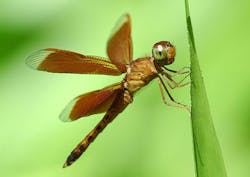DARPA eyes tiny insects as models for advanced SWaP-constrained artificial intelligence (AI) computing
ARLINGTON, Va. – U.S. military researchers are drawing on the evolution very small flying insects to improve artificial intelligence (AI) computing with reduced training times, improved computational efficiency, and low power consumption.
Officials of the U.S. Defense Advanced Research Projects Agency (DARPA) in Arlington, Va., issued a solicitation Friday (DARPA-PA-18-02-03) for the for the Microscale Biomimetic Robust Artificial Intelligence Networks (Micro-BRAIN) project.
DARPA scientists seek to develop new computational frameworks and strategies by drawing from the impressive computational capabilities of very small flying insects, which nature has forced to reduce their scale, size, and energy consumption without any loss of performance.
The past decade has seen explosive growth in development of AI systems, DARPA researchers explain. Nevertheless, the amount of computation necessary to train the largest AI systems has been increasing ten-fold each year as AI has taken on progressively more complex problems.
Related: Robot designers mimic cockroach antennae
Experts predict, moreover, that tradeoffs between computational capability, resources, and size, weight, and power consumption (SWaP) is becoming increasingly critical.
Although computer research in this area is going in the right direction, much more needs to be done, DARPA researchers say. Today's neuromorphic and neural architectures rely on digital computing that attempt to mimic the way nature computes, yet not the way nature functions. Biological systems like tiny insects may hold some keys to improvement.
For the Micro-BRAIN project, DARPA is asking for new ways of understanding integrated sensory and nervous systems in miniature insects and developing prototype computational models that could map onto computer hardware to emulate their functions.
Nature has forced on these small insects drastic miniaturization and energy efficiency, some having only a few hundred neurons in a compact form factor, while maintaining basic functionality, researchers explain.
Related: Insect-size aircraft of the future may revolutionize reconnaissance
Tiny bugs, moreover, may be able to display increased subjectivity of experience, which extends simple lookup table responses potentially to AI-based problem solving. This research could lead to new capabilities in inference, prediction, generalization, and abstraction of problems -- possibly in entirely news ways of finding solutions to compelling problems.
Ultimately, the goal is to understand the computational principles, architectures, and neuronal details of small bio-systems driven by extreme SWaP needs in nature. Doing could help identify new computing paradigms that will enable improved AI with considerably reduced training times and power consumption.
Researchers may be able to draw on several factors related to miniaturized insects, such as sensing, memory, processing, and actuations integrated into a system that can be smaller than a few human neurons.
Evidence, moreover, suggest even small insects have subjective experiences that could be the first steps towards consciousness. This could imply some ability to infer, generalize, and abstract.
Related: The Moon, Mars and beyond ...
The six-month first phase of the DARPA Micro-BRAIN program will map input/output channels of a model insect’s central intelligence system to understand physical interactions involved in signaling. The yearlong second phase will involve new AI computational hardware.
Proposers should understand not only computer science, signal processing, and computing architectures,but also the physiology of insects and their neural-sensory systems. Teams need to be able to identify the chemical and electromagnetic interactions involved in signaling in miniaturized distributed neural systems.
Companies and organizations interested should submit 8-page proposals no later than 4 Feb. 2019 to the DARPA BAA Website at https://baa.darpa.mil. The program may begin as early as 3 April. 2019.
Email questions or concerns the DARPA Micro-BRAIN program manager, Michael Fiddy, at [email protected]. More information is online at https://www.fbo.gov/spg/ODA/DARPA/CMO/DARPA-PA-18-02-03/listing.html.
Ready to make a purchase? Search the Military & Aerospace Electronics Buyer's Guide for companies, new products, press releases, and videos

